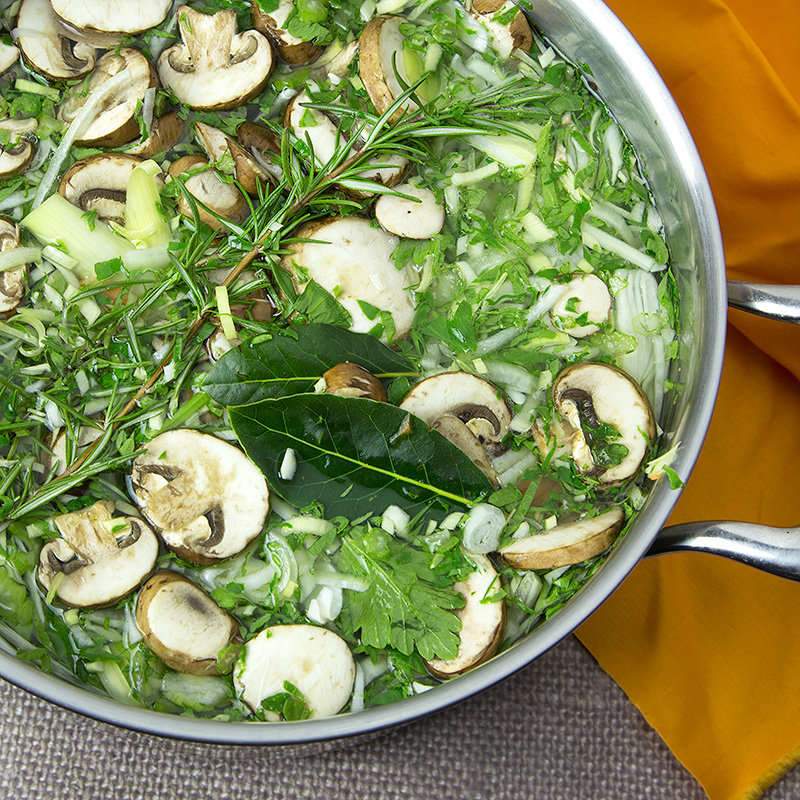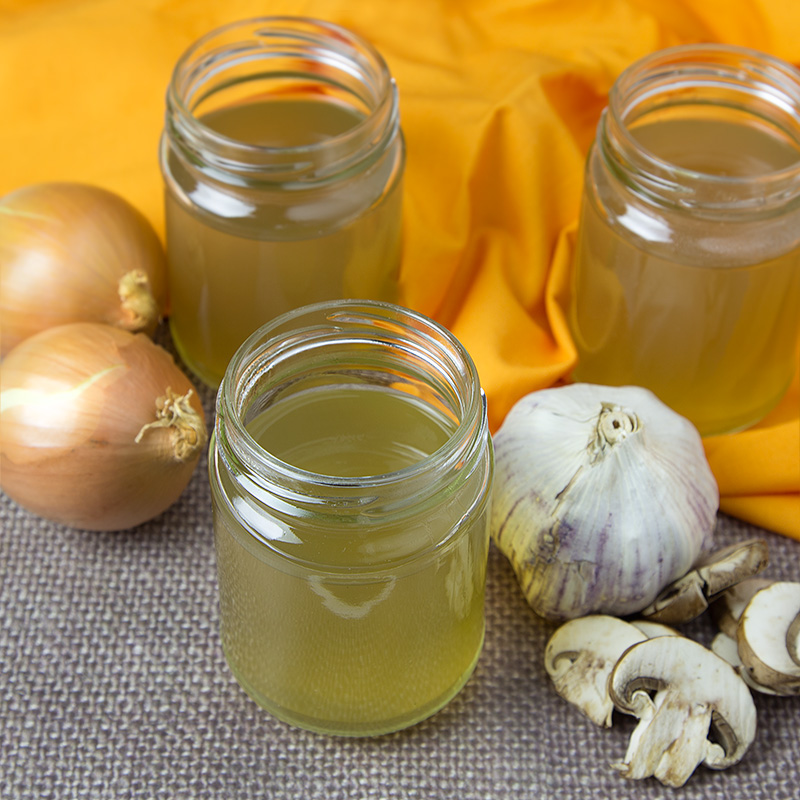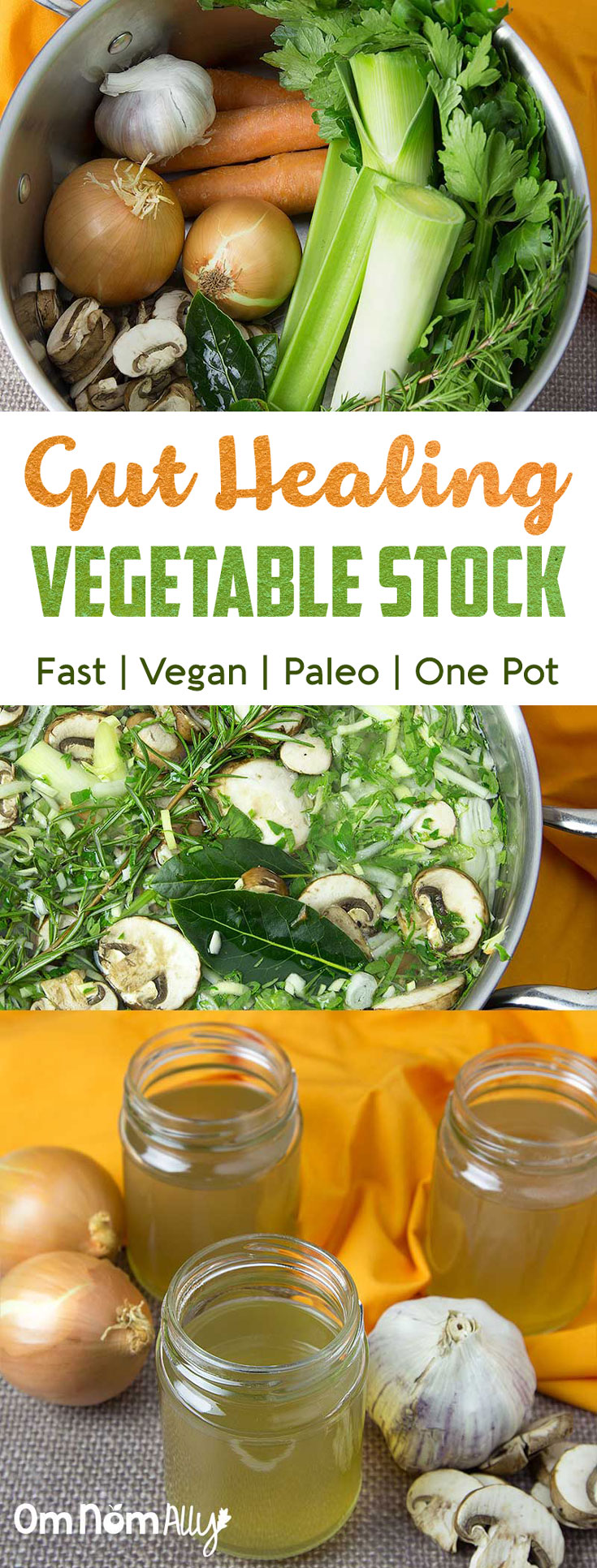 I’m totally committed to my monthly ritual of making home-made stock on the stovetop or slowcooker. Sometimes it’s a flavourful chicken stock or a beef bone broth that I’m cackling over in my kitchen cauldron; other times it’s this flavourful vegetable stock that I’m simmering away. It’s become a ‘must have’ and if I run out I get very upset having to fork out the cash for a product that never tastes the same, or as good.
I’m totally committed to my monthly ritual of making home-made stock on the stovetop or slowcooker. Sometimes it’s a flavourful chicken stock or a beef bone broth that I’m cackling over in my kitchen cauldron; other times it’s this flavourful vegetable stock that I’m simmering away. It’s become a ‘must have’ and if I run out I get very upset having to fork out the cash for a product that never tastes the same, or as good.
Making your own bone broths and stocks are two of the best ways to get gut healing gelatin and amino acids (especially glycine and proline) and should be a staple of every omnivore’s cooking arsenal. Not everyone out there enjoys animal-foods in their diet though, which is why you need this recipe for gut healing vegetable stock in your life. It’s rich on flavour and also possesses incredible nutritional benefits.

This stock is based on the mirepoix of French cooking (carrots, celery and onion); an aromatic combo of vegetables that is often used to add flavour to soups, stocks and stews. The real focus of this recipe however is on the gut healing properties of onions, leeks, garlic and mushrooms. Allium genus plants (onions, leeks & garlic) are naturally antibiotic foods and useful particularly in the treatment of leaky gut.
With anti-inflammatory and anti-allergic properties, the quercetin content of onions makes it an important ingredient in this stock as it decreases intestinal permeability through a ‘sealing’ effect. Garlic is anti-inflammatory and antimicrobial across body systems, and has anti-candida and anti-cancer properties. All three vegetables are recommended in the GAPS diet and are also naturally rich in prebiotics that promote the growth of healthy bacteria in the large intestine.

By using mushrooms (particularly shiitake) in your stock you get a wonderful dose of intestinal membrane-healing zinc; they also contain immune boosting polysaccharides. For this batch of stock I’ve used Swiss brown mushrooms (cremini mushrooms) as I’m out of dried shiitake, but they still possess amazing antioxidant, anti-inflammatory and immune system benefits.
Another fantastic bonus of using mushrooms in your stock? The exquisite, earthiness of mushrooms intensifies the longer you cook them, contributing to the more concentrated flavours in this healing and nourishing vegetable stock. Make a big batch on the stove and then freeze in 1-2 cup amounts, or in ice cube trays to start making the best soups and stews of your life!
Note: With any digestive conditions, it is better to follow your own body’s needs when it comes to eating onions, garlic and mushrooms. Some people will react to these foods in active disease, while others will thrive on them.
If you have a FODMAP sensitivity, this recipe is best to include in your diet after you have completed an appropriate elimination diet for at least two months in conjunction with nutritional treatment for intestinal permeability. Onions and garlic can elicit strong reactions in IBS patients, which can be a sign of further digestive distress (including untreated leaky gut syndrome). I recommend this book by Sue Shepherd for anyone starting out with the FODMAP diet protocol, also speak to your naturopath or health practitioner for more information on these conditions.

- 1 tbsp coconut oil
- 2 large onions, chopped
- 2 medium leeks, white parts only, rinsed and sliced thinly
- 4 cloves garlic, peeled and minced
- 3 medium carrots, peeled
- 1 cup mushrooms (shiitake preferred), sliced
- 2 celery stalks with leaves, sliced
- 1 tbsp apple cider vinegar
- 2-3 bay leaves
- Herbs: 1-2 springs of thyme or rosemary (optional)
- 3-4 L water (see notes)
- Optional Step: Heat coconut oil in a large stock pot, and saute vegetables over medium high heat until softened, about 5 minutes.
- Combine vegetables, apple cider vinegar, water bay leaves and herbs (if using) and bring to a boil. Lower heat to simmer and cook stock, uncovered, over a low heat for 40-50 minutes.
- After cooking time has elapsed, take stock pot off the heat and use a slotted spoon to remove solids. Pour stock through a fine mesh sieve lined with cheesecloth into a large glass bowl or container, discarding remaining solids. Portion stock into containers of 250 or 500ml volume and allow to cool completely before storing in the fridge or freezer.
- Stock may be refrigerated for up to one week, or frozen for up to three months. Ensure there is plenty of head room in storage containers for expansion when frozen.
If you currently experiencing symptoms of IBS or Fructose Malabsorption, it would be preferable to start with a lighter-flavoured stock (using the whole 4L of water) and experiment with using half stock and half water in your soups, stews or braised recipes.

Comments 43
Homemade stock is an absolute luxury! I don’t think to make it often enough, despite how easy it is. I love having a big batch on hand in the winter so I can drink it like tea.
Author
I love to drink it like tea too Hannah, it’s so warming and comforting in those chilly winter months! Thanks for dropping by and commenting 🙂
I need to get in the habit of making stock at home – I’ve done it a few times but really would love to make it part of my routine!
Author
It took me a while to get into it too Ashley – I’m not really sure what made it become a habit but about a year ago the desire to always have real stock really important to me. Recently I ran out and had some old, tinned, powdered stock in the pantry that I used instead and I couldn’t believe how salty and unpleasant my soup tasted. I think my taste buds have changed after making my own!
I urge you to give this vegie stock a try, it’s much fasted to make than a bone stock if you’re pressed on time, but still delicious! Thanks for the comment 😀
YUM! This looks and sounds perfect! Great photos, too! Tis the season for this kind of stuff, eh!? Great…now I want soup! LOL 🙂 teehee
Author
Hahah, seeing stock recipes has that effect on me too! I start daydreaming about soup…. stew… slow cooker meals… and then I found myself salivating 😀 Thanks for the kind words Jennifer!
This is very similar to how I make my broth! I have never used shiitake mushrooms, though so I will definitely give it a try! I use cremini most of the time. My broth never lasts very long… it’s usually gone within 2 days – we love using it in everything we make 🙂
Thanks for all the nutritional information, Ally, it makes me want to make broth right this minute! Your photos are beautiful!
Where can I find the recipe for the beef stock and chicken stock you use at home?
Author
Currently I only have the vegetable stock recipe on the website Gioia, I do however have plans to post my chicken and beef stock recipes but I’m not sure exactly how soon that will be. Best bet would be to ‘Like’ Om Nom Ally on Facebook or join the newsletter, that way you will be notified as soon as a new post goes live 😀 Sorry to disappoint!
I made this and used 3 liters of water and it had no flavor! Just warm water! I had to add tomato bullion and salt AND chicken to get some flavor!
Author
I’m so sorry to hear it had no flavour Vicky 🙁 I’ve been using this recipe, or very similar for a while and it’s always been fabulous as a base for other recipes. Do you regularly make your own stock? You mentioned adding bouillon and salt – is it homemade bouillon (stock) or powdered/cubes? If you are used to cooking with packaged bouillon to make stock then this homemade version may taste much less strong in flavour (as bouillion powder or cubes are very high in salt and may contain yeast extract and other flavour enhancers).
Otherwise it’s absolutely fine to add salt, pepper or other flavourings to this stock for taste and I too have used it with chicken for added flavour as well – it’s fabulous as the base for a healing chicken soup or stew. Please let me know any further information for the flavour issue and I’ll reply as best I can 🙂
thanks so much for the recipe
Author
It’s my pleasure Denise 🙂 Thanks for the comment!
this might be a dumb question but -you don’t eat the veggies? (Like a veggie soup?)
Author
Great question Cat! By the time we are finished making the stock, we have effectively cooked all the nutrients out of the vegetables to enable them to leach into the cooking water. What’s left are some very soggy, wilted and not very appetising vegetables. If making a soup and simmering for a shorter time we would certainly eat them, but there isn’t much pleasure in eating the vegies in this case.
Pingback: fOOd - calyxtherapeuticbodyworks | Pearltrees
Can you cook this in a crockpot?
Author
Absolutely Jessica, I would usually cook this on the low setting (approximately 8 hours cook time)
If you cook this in a crockpot, do you still need to heat the coconut oil on the stove and saute the vegies before putting them in the crockpot?
Author
It’s completely optional Sarah, feel free to skip and go ahead with the rest of the recipe 🙂
Do you think this would can well? Everything I have read says canning preserves the nutrition as well as any other method. I like the idea of it being shelf stable.
Thanks for the help.
Author
I’m afraid I don’t have an answer for this Jill 🙁 I’m not a canner so I don’t know the ins and outs of how to process it. I hope you find an answer and sorry I couldn’t help!
Can this be made without the coconut oil? Will is still taste good if it’s left out? Thanks
Author
You can absolutely leave out the coconut oil Tricia, it’s only used for the optional step of sauteing the vegetables in step 1. Of you still want to cook the veggies down you could use ghee, butter or any other cooking fat, otherwise skip it and continue on!
I’m new to making vegetable broth and I’m wondering if you just toss all the veggies after it is made. Seems like a waste, but I know most of the nutrients are cooked out.
Author
You’re right Kaylie, the vegetables are thrown out (or composted if you can) as they have emptied all their nutrient content into the stock liquid. Once you finish cooking they definitely don’t appear very appetising either, so you really wouldn’t want to eat them!
Hi, thanks for sharing this! I am making this today. Will I get the same results if I dont use the celery leaves?
Author
It will be fine without the leaves Tiffany, they just add more of that beautiful, savoury-salty ‘celery’ flavour
This vegetable stock is delicious. I used several sprigs of thyme as well as a couple small pieces of rosemary.
Author
That sounds amazing Karen, I’m so glad you loved the stock recipe. Your tweaks are great 😀
Hello Allison! This recipe looks wonderful!!
Can you share how we would modify the recipe to actually eat it as a whole soup wither the veggies and all rather than just a stock?
And Would we still get the gut healing benefits making it as a whole soup rather than just broth?
Thanks!!!
Author
Thanks Jess 🙂 I make this stock a lot as the base of my soups and stews – though on its own it’s really not appealing to eat the vegetables once they’ve released all their nutrients and flavour into the water. Instead, to eat as a soup, you would need some stock already made, then put together the following:
1 tbsp coconut oil
1-2 brown onions, finely diced
3 cloves garlic, minced
2 medium carrots, thinly sliced or finely chopped
1 medium zucchini, thinly sliced or finely chopped
2 stalks celery, thinly sliced
1/2 cup mushrooms, thinly sliced or finely chopped
2 cups kale, silverbeet or spinach, finely chopped
3 cups vegetable or herb stock
1 400g can organic crushed tomatoes, or 4 roma tomatoes, diced
1 400g can organic chickpeas, or 1 1/2 cups cooked beans
2 cups kale, silverbeet
Herbs: Try oregano, rosemary, thyme or sage; or paprika with a squeeze of lemon on serving
Saute onions in coconut oil until softened and translucent. Add garlic and cook, stirring, until softened and aromatic. Add remaining vegetables and cook for 2-4 minutes or until softened and greens have wilted.
Add stock liquid and tomatoes, and add any herbs or spices of choice, as well as salt and pepper for seasoning. Bring mixture up to a boil, then lower to a simmer for 5-10 minutes or until soup has reduced slightly. Taste again before serving, checking for seasoning.
Pingback: Fall CSA – Week of November 16 | Your CSA
I didn’t have any leeks on hand and threw in some cauliflower, fennel, zuchinni and green beens I had so they wouldn’t go to waste. I used dried rosemary and thyme, as I didn’t have fresh on hand. I used frozen mushrooms and threw them in at the last minute without sauteing in the coconut oil, as I reread your info while I was waiting for the boil. I saw your info on the benefits of mushrooms and looked through the freezer as I sometimes keep frozen mushrooms, and I was in luck. It’s simmering now and I can’t wait to taste it, as it smells wonderful!
Author
This sounds AMAZING! Hope it turned out awesomely 😀
Pingback: Gut Healing Vegetable Stock – Taste
This is a super informative article / recipe! I love that you include each benefit each ingredient brings to the table. I think there is a lack of this sort of knowledge when it comes to recipes and food bloggers. Having someone who knows exactly the vitamins and minerals each product is bringing to the stock is beneficial especially for people who have conditions that need or cannot consume a particular ingredient. Thank you for sharing your knowledge!
I do a lot of canning, so i can tell you that it will can just fine! I normally do 5lbs of pressure for 10 minutes, but it would be wise to check out the suggested weight and time for your area. Your pressure canner manual will have that information! Unfortunately, with canning you do lose some nutritional value because it is being heated to a very high temp. But it will still have a lot of nutritional value to it, regardless, and will still taste great!!
P.s. – if you add meat products to this, the time and pressure needed will increase exponentially. Just so you know.
husband is allergic to onion =(
Author
That’s ok! Skip the onions and use more of the other aromatic ingredients, the best thing about stock is being able to tailor it to your needs 🙂
Why do you add apple cider vinegar?
Author
It helps to leach the nutrients out of the ingredients, and increases depth of flavour 🙂